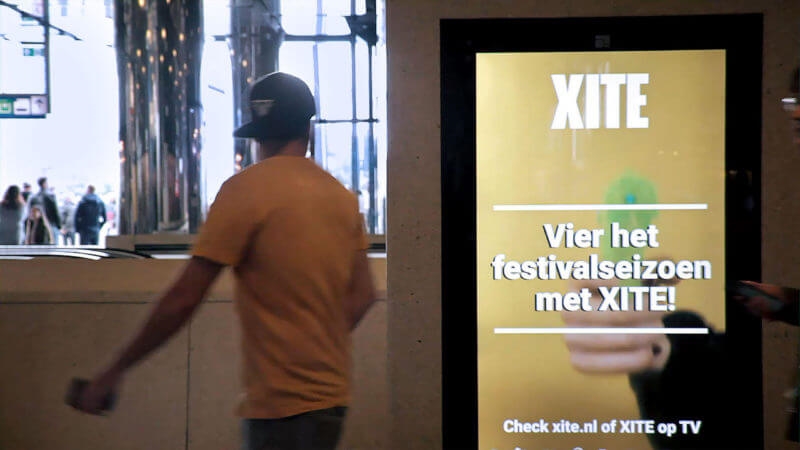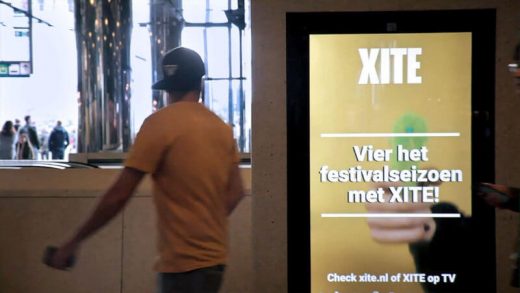Two DSPs add out-of-home programmatic inventory, as the real world becomes another channel
Announcements this week by Adelphic and MobPro highlight new forms of retargeting, attribution, real-world based audience targeting and multi-channel coordinated campaigns.

An out-of-home ad for XITE. part of a multichannel programmatic campaign.
Two recent integrations of digital-out-of-home (DOOH) advertising show not only that such ads are rapidly becoming a full-fledged member of the digital ad ecosystem, but that they are creating new kinds of DOOH-enhanced, cross-channel marketing.
Adelphic, a demand-side platform (DSP) acquired last year by ad tech firm (and Myspace owner) Viant, announced this week that DOOH inventory from Rubicon Project’s private marketplace is now available to its buyers.
And mobile-oriented, Amsterdam-based DSP MobPro says it is now integrated with DOOH marketing platform Broadsign.
DOOH goes programmatic. The Adelphic partnertship with Rubicon Project means marketers can “programmatically buy digital signage within a certain radius of the store location,” VIant CMO Jon Schulz said. That means Adelphic can now offer digital signage in physical proximity to a store as part of a campaign that includes ads on mobile phones, for example. As a result, advertisers can retarget consumers on a nearby outdoor screen after they’ve been shown a location-specific mobile or desktop ad.
With this, the definition of “retargeting” is now enlarged to include ads that follow you into the real world, not just to the next web site. Or that go the other way, following consumers from real-world exposure into audio, connected TV or mobile channels.
Additionally, Adelphic says this range of inventory helps its ability to tell advertisers how much of an impact their nearby DOOH ad exposure had on in-store or online sales, using such factors as customer location data and, for roadside signs, direction of travel. The exposure attribution can be tied into subsequent site visits, online and physical store visits, and sales.
With Rubicon Project’s Impression Multiplier tool in particular, the DSP says it can calculate “expected number of views” on outdoor signage, and then convert those to digital impressions.
Programmatic DOOH in action. MobPro’s integration with the SSP Broadsign’s DOOH inventory allows advertisers to buy mobile and outdoor inventory programmatically as part of the same campaign.
The first campaign using this expanded inventory promoted the Dutch music video brand XITE in its home country during the local music season.
Traditionally, MobPro said, a purchase of digital out-of-home screen space involves choosing a location and a time of day, such as during peak commuting times if it’s a digital billboard.
By contrast, programmatic lets advertisers evolve from buying a DOOH location and time to buying an audience, as targeted programmatic campaigns often do for site and app advertising. The platform is able to employ data that runs ads on the out-of-home signage when those audiences are present.
In this XITE campaign, the programmatic buy delivered ads for the music video service to screens in train stations throughout the Netherlands, but only when the targeted young music-inclined audiences were most likely to be walking by — such as during peak travel times for nearly music concerts.
The outdoor ads were coordinated with location-based mobile ads, demonstrating the new coordination possible between digital-realm and physical-world ad campaigns. MobPro said it reached 150,000 festival goers with out-of-home ads, and 200,000 in post-festival retargeting with both out-of-home and mobile ads.
Why you should care. As the two examples above indicate, real world signage has now become another channel on programmatic platforms, with The Rubicon Project projecting DOOH ad spending reaching $7.8 billion this year.
As a result, automated campaigns can now coordinate ads, including retargeting, between real world and the digital world. For marketers, it’s now all one space to reach consumers.
This story first appeared on MarTech Today. For more on marketing technology, click here.
Marketing Land – Internet Marketing News, Strategies & Tips
(7)



